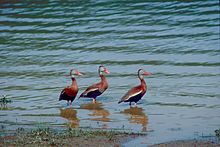Autumn Whistling Goose
| Autumn Whistling Goose | ||||||||||||
|---|---|---|---|---|---|---|---|---|---|---|---|---|

Autumn Whistling Goose ( Dendrocygna autumnalis ) |
||||||||||||
| Systematics | ||||||||||||
|
||||||||||||
| Scientific name | ||||||||||||
| Dendrocygna autumnalis | ||||||||||||
| ( Linnaeus , 1758) |

The autumn whistled goose ( Dendrocygna autumnalis ) is a species of the duck bird family . The autumn whistle goose is native to both Americas. Since the 1950s, the northern autumn whistled goose has even been able to expand its breeding area from Mexico to the southern states of the USA. The species does not play a role as game. Similar to the pygmy whistle in Southeast Asia , which belongs to the same genus, it is considered a pest in agriculture and is therefore persecuted like the latter.
description
As is characteristic of whistling geese , autumn whistling geese show no sexual dimorphism. The body length of the nominate form is about 53 centimeters. Males weigh between 728 and 951 grams, while females weigh between 831 and 978 grams. Autumn whistling geese have the characteristic physique of all whistling geese: long legs, long necks and broad wings. What is striking is the very upright posture these ducks assume. During the breeding season, reproductive fall whistle geese have a crimson beak. After the end of the breeding season, it fades to a pale red-brown again. The white eye ring is striking.
Two subspecies are distinguished for the species, which differ in breast color and body size. The northern autumn whistle goose ( D. a. Autumnalis ), which is the nominate form , is the significantly larger subspecies. It has a reddish brown color on the breast. The slightly smaller and dainty southern plover ( D. a. Fulgens ) has a gray breast instead. Both have a black belly and black flanks.
In contrast to the adult birds, the not yet sexually mature plover geese have a whitish belly. Their flanks still appear brownish.
The flight of the fall whistle geese is slow and erratic. The long legs are stretched far back. Autumn whistle geese are also very happy to call. The call is whistling and sounds pe-che-che-che and wa-chu-whe-whe .
Distribution, habitat and way of life
Fall whistle geese are relatively common birds, their range from the southern edge of the USA to central Argentina. Over the past three decades, this duck bird has expanded its range and is now found in Texas and Arizona . They have also been seen as random visitors in Missouri, New Mexico and southern California. At least the breeding populations in the US are short-range migrations. They migrate a few hundred kilometers to northern Mexico from August to October and return to their breeding grounds in April. The same applies to the southernmost populations in South America, which then move north. The populations that breed in the rainforest zone are true to their location.
Autumn whistle geese are inhabitants of nutrient-rich shallow waters. They can be found both in swamps and on river plains, in wooded regions and in backwaters in agricultural areas. Where available, they like to build on trees and large shrubs. Similar to other whistling geese, the autumn whistling geese also form large swarms when the birds gather at residual water in regions with periodic rainfall.
Autumn whistle geese are crepuscular and nocturnal. During the day they rest in and on the shore zone. The main part of the diet consists of grain, grass and wild millet. There are also small animals that they take up in the water.
Reproduction
Fall whistle geese nest in tree hollows that are in close proximity to the water. A clutch usually consists of twelve to 16 white eggs, which are incubated by both parent birds for between 23 and 30 days. The downy cubs leave the nest around a day old and are led by both parent birds. Downy young fledglings after about 56 days.
Occasionally autumn whistle geese also lay their eggs in clutches of bridal ducks , which these often raise successfully with their brood.
Systematics
There are two subspecies for the species. The northern autumn whistle goose ( D. a. Autumnalis ), which is the nominate form , is the significantly larger subspecies. It has a reddish brown color on the breast. The slightly smaller and dainty southern plover ( D. a. Fulgens ) has a gray breast instead.
The exact relationships of the whistling geese are as follows:
| Whistling Geese (Dendrocygninae) |
|
|||||||||||||||||||||||||||||||||||||||||||||
|
|
Individual references, literature and web links
Individual evidence
- ↑ Alderfer, p. 3
- ↑ Gooders and Boyer, p. 13
- ↑ Christopher S. Smith: Field Guide to Upland Birds and Waterfowl , Wilderness Adventure Press, Belgrade (Montana) 2000, ISBN 1-885106-20-3 , p. 76
- ↑ Alderfer, p. 3
- ↑ Gooders and Boyer, p. 14
literature
- Jonathan Alderfer (Ed.): Complete Birds of North America , National Geographic, Washington DC 2006, ISBN 0-7922-4175-4
- T. Bartlett: Ducks And Geese - A Guide To Management. The Crowood Press, 2002, ISBN 1-85223-650-7
- John Gooders and Trevor Boyer: Ducks of Britain and the Northern Hemisphere , Dragon's World Ltd, Surrey 1986, ISBN 1-85028-022-3
- Hartmut Kolbe: The world's ducks. Ulmer Verlag 1999, ISBN 3-8001-7442-1
Web links
- Dendrocygna autumnalis inthe IUCN 2013 Red List of Threatened Species . Listed by: BirdLife International, 2012. Retrieved September 8, 2013.

